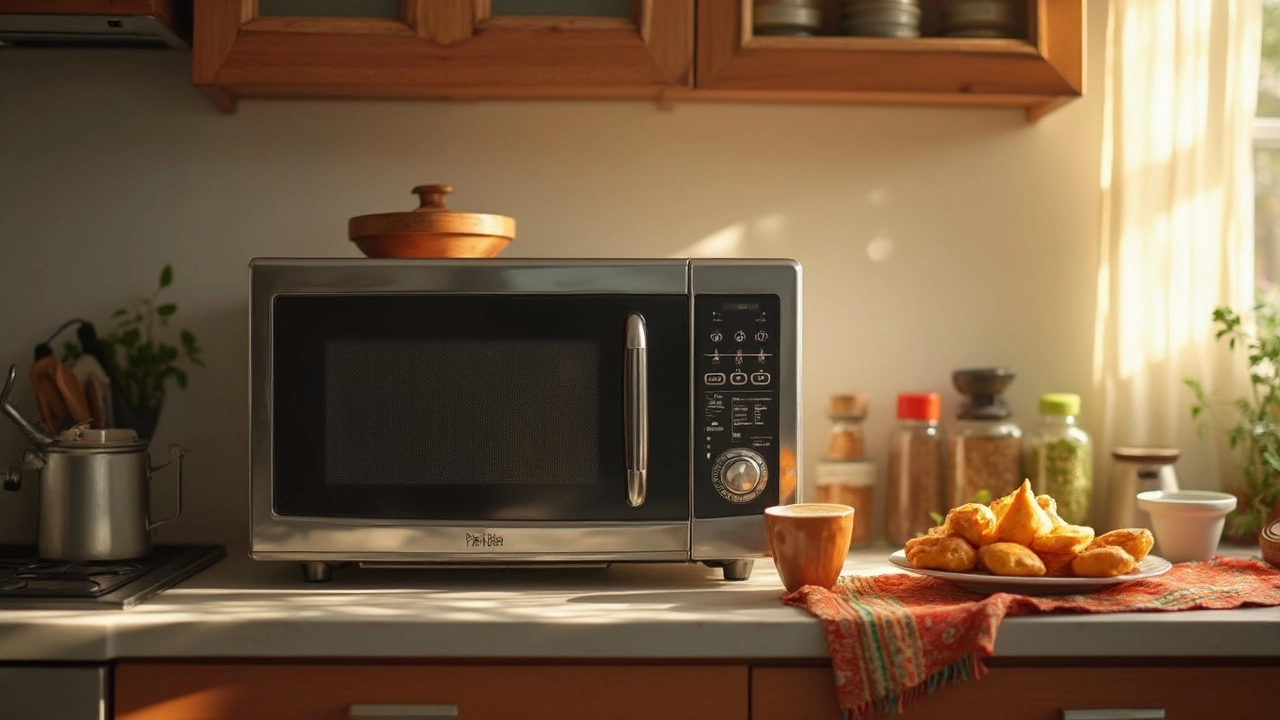
If you’re hungry and in a hurry, no one grabs the oven manual—they hit the microwave’s “start” button. You don’t need to preheat, wait, or babysit your food. Toss in a plate of leftovers or a couple of frozen burritos and they’re piping hot in minutes. For busy mornings or late-night snacks, it’s honestly a lifesaver.
Here’s the kicker: microwaves don’t just heat fast, they use way less energy than ovens. While an oven can suck up to 2400 watts each hour (like running three hair dryers at once), your microwave sips around 1000 watts and doesn’t need to run nearly as long. That kind of efficiency shows up on your power bill over time—less wasted heat, less money down the drain.
- Speed and Convenience
- Energy Use and Cost
- Special Features for Everyday Use
- When an Oven Still Makes Sense
Speed and Convenience
That speed isn’t just about impatience—it makes a real difference if you’re managing work, family, or a tight schedule. Getting a hot meal in minutes instead of half an hour can mean eating dinner before another Zoom call, or warming a snack quickly for a hungry teenager.
Convenience is the other half of the story. Using a microwave is dead simple—most have just a few buttons, some even have built-in sensors that auto-adjust cooking time. You don’t need to mess with trays or racks, and cleaning up is usually just a matter of wiping down the turntable. That’s why a lot of folks end up using their microwave for pretty much everything from reheating coffee to popping popcorn, or making scrambled eggs in a mug.
Let’s not forget portability. If you live in a small apartment, a dorm, or even travel in an RV, a microwave often gets a spot that an oven never would. The real kicker? Modern models have quick cook presets, so you press one button and walk away while the microwave does all the thinking for you.
- No need to preheat—just set and start.
- Perfect for one-plate meals or small servings.
- Won’t heat up your kitchen on a hot summer day.
- Can easily move or unplug when rearranging your space.
All of this means if you want something fast and easy, the microwave usually comes out way ahead of the oven. It’s not just a backup—it’s the go-to for anyone who values their time.
Energy Use and Cost
Most people don’t realize how much more energy an oven eats up compared to a microwave. Here’s how it breaks down: a typical microwave runs at about 1000 watts, where an electric oven usually runs anywhere from 2000 to 5000 watts. That means the oven uses over twice the electricity while taking longer to actually cook your food.
Let’s say you’re heating up leftovers. Ten minutes in an oven versus two in a microwave isn’t just about time. It’s about your wallet too. Here’s a quick look at how much you could spend if you used each appliance for 15 minutes:
| Appliance | Power (Watts) | Typical Time (Minutes) | Approx. Cost per Use* |
|---|---|---|---|
| Microwave | 1000 | 3 | $0.01 |
| Electric Oven | 2400 | 15 | $0.07 |
*Based on average U.S. electricity rates (15¢ per kWh). Your mileage may vary a bit depending on where you live and your exact appliance model, but the microwave nearly always costs less.
It’s easy to see on your utility bill—if you swap most of your quick-cooking tasks to the microwave, you’re looking at real savings over a month. Plus, the microwave doesn’t heat up your whole kitchen, so you save on air conditioning during summer too. Ovens can make your house hot, forcing your AC to work harder; the humble microwave doesn’t have that problem at all.
If you’re cooking simple stuff or reheating, go with the microwave and watch those energy costs drop.

Special Features for Everyday Use
Today’s microwaves are packed with clever options that make your day-to-day cooking feel almost too easy. If you’ve only used yours for reheating pizza, you’re missing out. The most obvious perk? Popcorn mode. One button and you’re crunching away, no need to watch and guess like with an oven.
Most microwaves now offer sensors that check steam or humidity, then auto-adjust cooking times so you don’t have to babysit your food. This protects your lunch from ending up as a dry brick or a soggy mess. Certain models let you defrost by weight – just punch in what you’re thawing, and those cold chicken breasts are ready to cook in a fraction of the time compared to waiting on a countertop or fussing with the oven.
Here’s a quick look at some top everyday features and why they matter:
- microwave-safe presets: Common foods like potatoes, veggies, and beverages cook with a single press.
- Child lock: Stops curious little hands from starting the microwave.
- Turntables and stirrers: For even heating, preventing those fridge-cold centers.
- Inverter tech: Allows low-and-slow melting of chocolate or butter—hard to match with an oven.
Curious about how these features stack up? Here are some real differences you’ll notice when you use them:
| Feature | Microwave | Oven |
|---|---|---|
| Popcorn setting | Yes, one button | No, manual guesswork |
| Sensor cooking | Auto-adjusts time | Only basic timers |
| Quick defrost | Under 10 minutes | Can take hours |
| Energy use for quick meals | Low | High |
| Safe for kids | Child locks built in | Needs supervision |
And let’s not skip the easy cleaning. No more scraping burnt cheese off oven walls—just wipe down the microwave’s turntable. These straightforward features are lifesavers for busy days, hungry kids, or anyone who wants results right now with as little hassle as possible.
When an Oven Still Makes Sense
Microwaves are champs for quick meals and reheating, but there are times when only an oven can do the job right. If you want a crispy pizza crust or golden-brown baked cookies, the microwave just can’t compete. Ovens handle roasting, baking, and caramelizing way better—they surround your food with even heat and let you cook bigger portions in one go.
Baking bread? Roasting a chicken? Trying to get that Thanksgiving turkey juicy and evenly browned? There’s no shortcut for these. One recent kitchen appliance report showed that “over 80% of home bakers prefer ovens for getting consistent results with cakes and breads,” so you’re not alone if you reach for the oven on bake day.
"Ovens create a dry, circulating heat that makes it possible to brown, crisp, and caramelize food, all things a microwave simply can’t do well."
Check out this quick breakdown between microwave and oven tasks:
| Task | Microwave | Oven |
|---|---|---|
| Reheating leftovers | Best | Slower, not as even |
| Roasting vegetables | Not ideal | Excellent |
| Baking cookies | Can dry out or stay soft | Perfect browning |
| Making popcorn | Quick and easy | Possible, but takes longer |
| Crisping pizza | Not great | Gets a great crust |
If flavor and texture matter, like when you want crispy fries or melt-in-your-mouth roast, the oven wins. Sure, for speedy snacks the microwave is king, but the microwave isn’t meant for every recipe. Just use each tool for its strengths and you’ll get the best of both worlds.